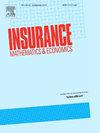最优资本配置的广义尾均值-方差模型
IF 2.2
2区 经济学
Q2 ECONOMICS
引用次数: 0
摘要
资本配置是金融精算风险管理的核心任务。一些著名的资本配置原则,如“欧拉原则”和“理发原则”,已被广泛应用于银行和保险业。分配资本的分割不仅可以作为潜在损失的缓冲,还可以为潜在风险提供一定的风险定价和绩效衡量。Dhaene et al.(2012)提出了统一的距离最小化资本配置框架。他们在优化中的目标函数只考虑损失函数的大小而不考虑可变性。在本文中,我们提出了一个通用的尾部均值方差(GTMV)模型,该模型采用Bregman散度构造距离最小化函数,同时考虑了幅度和可变性。我们证明了最优分配的存在唯一性,并给出了表征最优解的一般方程组。在此背景下,我们进一步引入了马氏尾均值方差(MTMV)模型,并提供了明确的无分布最优分配公式,作为特例涵盖了许多已有的结果。特别地,我们导出了多元广义双曲分布风险的参数解析解。对于多元对数-广义双曲分布非负风险,我们使用凸逼近方法得到显式解。我们给出了两个数值例子,证明了我们的最优资本配置规则的良好性能。第一部分分析了标普500行业板块指数的市场风险。我们的研究表明,我们的最优资本配置框架适用于各种情景分析,并为指数和金融市场提供了一个绩效衡量指标。另一个例子是基于一家澳大利亚保险公司的保险索赔,表明我们的近似公式既稳健又准确。本文章由计算机程序翻译,如有差异,请以英文原文为准。
A generalized tail mean-variance model for optimal capital allocation
Capital allocation is a core task in financial and actuarial risk management. Some well-known capital allocation principles, such as the “Euler principle” and the “haircut principle”, have been widely used in the banking and insurance industry. The partitions of allocated capital not only serve as a buffer against potential losses but also provide certain risk pricing and performance measurement to the underlying risks. Dhaene et al. (2012) proposed a unified distance-minimizing capital allocation framework. Their objective function in the optimization only considers the magnitude of the loss function but not the variability. In this paper, we propose a general tail mean-variance (GTMV) model, which employs the Bregman divergences to construct distance-minimizing functions, and takes both the magnitude and the variability into account. We prove the existence and uniqueness of the optimal allocation and provide the general system of equations that characterizes the optimal solution. In this context, we further introduce the Mahalanobis tail mean-variance (MTMV) model and provide explicit distribution-free optimal allocation formulas, which cover many existing results as special cases. In particular, we derive the parametric analytical solutions for multivariate generalized hyperbolic distributed risks. For multivariate log-generalized hyperbolic distributed non-negative risks, we use the convex approximation method to obtain explicit solutions. We present two numerical examples showing the good performance of our optimal capital allocation rules. The first one analyzes the market risk of S&P 500 industry sector indices. We show that our optimal capital allocation framework is applicable to various scenario analyses and provides a performance measure for the indices and the financial market. The other example is based on insurance claims from an Australian insurance company, showing our approximate formulas are both robust and accurate.
求助全文
通过发布文献求助,成功后即可免费获取论文全文。
去求助
来源期刊

Insurance Mathematics & Economics
管理科学-数学跨学科应用
CiteScore
3.40
自引率
15.80%
发文量
90
审稿时长
17.3 weeks
期刊介绍:
Insurance: Mathematics and Economics publishes leading research spanning all fields of actuarial science research. It appears six times per year and is the largest journal in actuarial science research around the world.
Insurance: Mathematics and Economics is an international academic journal that aims to strengthen the communication between individuals and groups who develop and apply research results in actuarial science. The journal feels a particular obligation to facilitate closer cooperation between those who conduct research in insurance mathematics and quantitative insurance economics, and practicing actuaries who are interested in the implementation of the results. To this purpose, Insurance: Mathematics and Economics publishes high-quality articles of broad international interest, concerned with either the theory of insurance mathematics and quantitative insurance economics or the inventive application of it, including empirical or experimental results. Articles that combine several of these aspects are particularly considered.
 求助内容:
求助内容: 应助结果提醒方式:
应助结果提醒方式:


